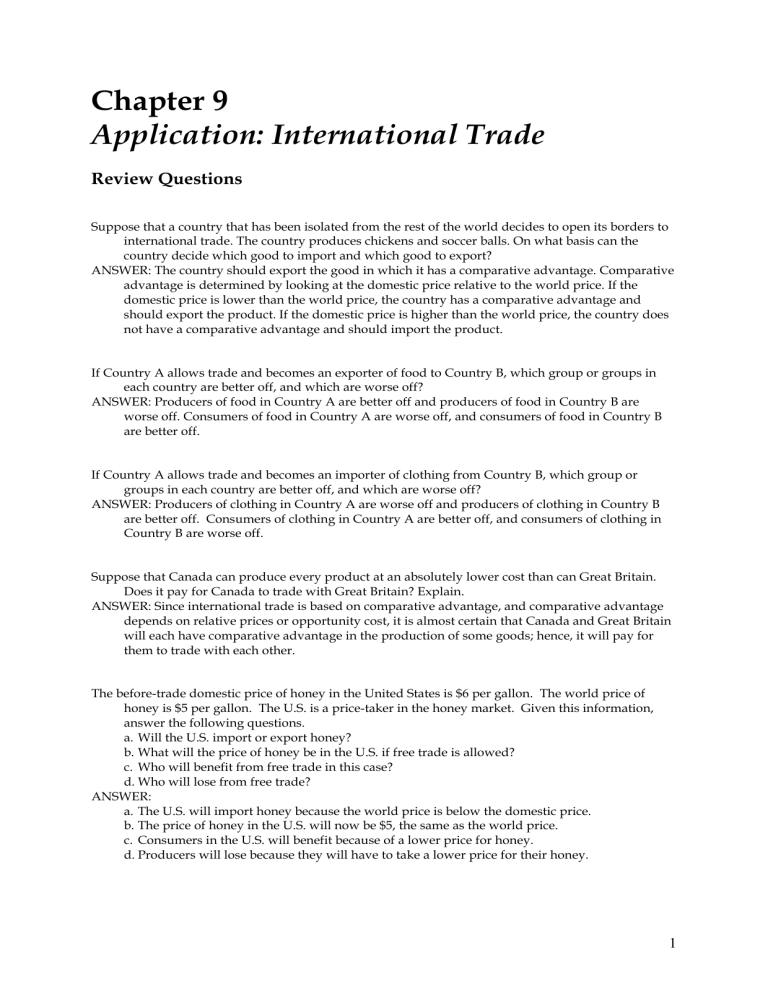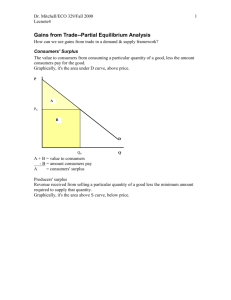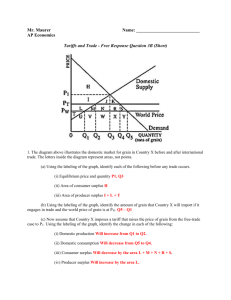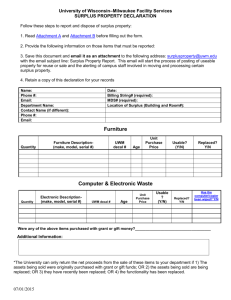Short questions

Chapter 9
Application: International Trade
Review Questions
Suppose that a country that has been isolated from the rest of the world decides to open its borders to international trade. The country produces chickens and soccer balls. On what basis can the country decide which good to import and which good to export?
ANSWER: The country should export the good in which it has a comparative advantage. Comparative advantage is determined by looking at the domestic price relative to the world price. If the domestic price is lower than the world price, the country has a comparative advantage and should export the product. If the domestic price is higher than the world price, the country does not have a comparative advantage and should import the product.
If Country A allows trade and becomes an exporter of food to Country B, which group or groups in each country are better off, and which are worse off?
ANSWER: Producers of food in Country A are better off and producers of food in Country B are worse off. Consumers of food in Country A are worse off, and consumers of food in Country B are better off.
If Country A allows trade and becomes an importer of clothing from Country B, which group or groups in each country are better off, and which are worse off?
ANSWER: Producers of clothing in Country A are worse off and producers of clothing in Country B are better off. Consumers of clothing in Country A are better off, and consumers of clothing in
Country B are worse off.
Suppose that Canada can produce every product at an absolutely lower cost than can Great Britain.
Does it pay for Canada to trade with Great Britain? Explain.
ANSWER: Since international trade is based on comparative advantage, and comparative advantage depends on relative prices or opportunity cost, it is almost certain that Canada and Great Britain will each have comparative advantage in the production of some goods; hence, it will pay for them to trade with each other.
The before-trade domestic price of honey in the United States is $6 per gallon. The world price of honey is $5 per gallon. The U.S. is a price-taker in the honey market. Given this information, answer the following questions. a. Will the U.S. import or export honey? b. What will the price of honey be in the U.S. if free trade is allowed? c. Who will benefit from free trade in this case? d. Who will lose from free trade?
ANSWER: a. The U.S. will import honey because the world price is below the domestic price. b. The price of honey in the U.S. will now be $5, the same as the world price. c. Consumers in the U.S. will benefit because of a lower price for honey. d. Producers will lose because they will have to take a lower price for their honey.
1
According to the graph shown, fill in the answers for the following questions. a. Consumer surplus before trade would be _______________. b. Consumer surplus after trade would be _______________. c. Producer surplus before trade would be _______________. d. Producer surplus after trade would be _______________. e. Total surplus before trade would be ______________. f. Total surplus after trade would be ______________.
ANSWER: a. A + B b. A c. C d. C + B + D e. A + B + C f. A + B + C + D
2
According to the graph shown, fill in the answers for the following questions. a. Consumer surplus before trade would be _______________. b. Consumer surplus after trade would be_______________. c. Producer surplus before trade would be _______________. d. Producer surplus after trade would be _______________. e. Total surplus before trade would be ______________. f. Total surplus after trade would be ______________.
ANSWER: a. A b. A + B + D c. B + C d. C e. A + B + C f. A + B + C + D
According to the graph, answer the following questions about lamps. a. What is the equilibrium price of lamps before trade? b. What is the equilibrium quantity of lamps before trade? c. What is the price of lamps after trade is allowed? d. What is the quantity of lamps exported? e. What is the amount of consumer surplus before trade? f. What is the amount of consumer surplus after trade? g. What is the amount of producer surplus before trade? h. What is the amount of producer surplus after trade? i. What is the change in total surplus because of trade?
ANSWER: a. $35 b. 60 c. $45 d. 44 e. $750 f. $270 g. $900 h. $1600 i. 220
3
According to the graph shown, answer the following questions about hammers. a. What is the equilibrium price of hammers before trade? b. What is the equilibrium quantity of hammers before trade? c. What is the price of hammers after trade is allowed? d. What is the quantity of hammers imported? e. What is the amount of consumer surplus before trade? f. What is the amount of consumer surplus after trade? g. What is the amount of producer surplus before trade? h. What is the amount of producer surplus after trade? i. What is the change in total surplus because of trade?
ANSWER: a. $8 b. 60 c. $5 d. 66 e. $150 f. $384 g. $180 h. $45 i. $99
4
Using the graph shown, assume that the government imposes a $1 tariff on hammers. Answer the following questions given this information. a. What is the domestic price and quantity demanded of hammers after the tariff is imposed? b. What is the quantity of hammers imported before the tariff? c. What is the quantity of hammers imported after the tariff? d. What would be the amount of consumer surplus before the tariff? e. What would be the amount of consumer surplus after the tariff? f. What would be the amount of producer surplus before the tariff? g. What would be the amount of producer surplus after the tariff? h. What would be the amount of government revenue because of the tariff? i. What would be the total amount of deadweight loss due to the tariff?
ANSWER:
5
a. $6, 84 b. 66 c. 44 d. $384 e. $294 f. $45 g. $80 h. $44 i. $11
Can a government always gain revenue from imposing a tariff?
ANSWER: No, a tariff may be so high that it effectively prevents any of the good from being imported, hence, there will be no tariff revenue collected.
What is the effect on the economic well-being of a nation if a tariff is imposed? Why?
ANSWER: A tariff reduces the economic well-being of a nation by reducing the quantity of imports and moving the domestic market closer to equilibrium without trade. As a result, the gains from trade are reduced and there is a deadweight loss.
Opponents of free trade often argue that trade must be restricted in order to save domestic jobs. As a free-trader, how would you counter this argument?
ANSWER: Even though free trade causes job losses in industries which do not have a comparative advantage, it creates jobs in industries which enjoy a comparative advantage. The short run hardship on some workers is more than balanced by the increased standard of living available to citizens as a whole. In the long run, workers displaced by trade will find employment in those industries which enjoy a comparative advantage and grow because of trade.
Define the two approaches a nation can take to achieve free trade. Does one approach have an advantage over the other?
ANSWER: A unilateral approach is when a country removes its trade restrictions on its own. A multilateral approach is when a country removes its trade restrictions while other countries do the same. A multilateral approach has two advantages. The first is that it has the potential to result in freer trade because it can reduce trade restrictions abroad as well as at home. If international negotiations fail, however, the result could be more restricted trade than under a unilateral approach. Also, the multilateral approach may have a political advantage and can sometimes win political support when a unilateral reduction cannot.
What are the arguments in favor of trade restrictions, and what are the counter-arguments? As an economist, do any of these arguments justify trade restrictions? Explain.
ANSWER: Arguments mentioned in the text include the jobs argument, the national-security argument, the infant-industry argument, the unfair-competition argument, and the protectionas-a-bargaining-chip argument. These arguments and counter-arguments are outlined in section
9-3 of the text. Most economists would dismiss the jobs argument, the infant-industry argument, and the unfair-competition argument on strictly economic grounds. The bargaining-chip argument carries high risks of economic harm if the threat doesn’t work. The national-security argument balances economic loss from trade restriction against the benefit of long-term national survival, and is probably the argument that economists would most likely buy if it was clear that the industry being protected was clearly crucial to national security.
Suppose that Mexico has a comparative advantage over the United States in producing computers, and the United States has a comparative advantage over Mexico in producing automobiles. By
6
reducing trade barriers, NAFTA allows both the U.S. and Mexico to export more of the product in which it enjoys a comparative advantage. Do all people in both countries benefit from this free-trade agreement? Explain.
ANSWER: While overall economic well-being in both countries increases, not everyone benefits in the short run. In particular, some workers in the U.S. computer industry become unemployed, and some workers in the Mexican automobile industry become unemployed. In the long run, displaced workers will find employment in the industries that enjoy a comparative advantage.
7






